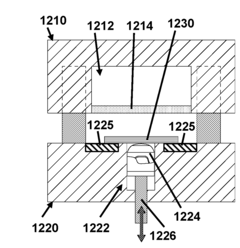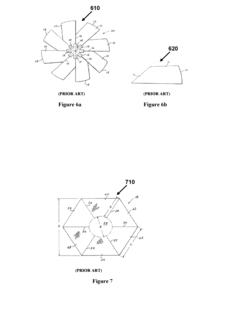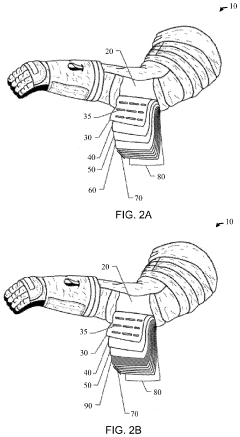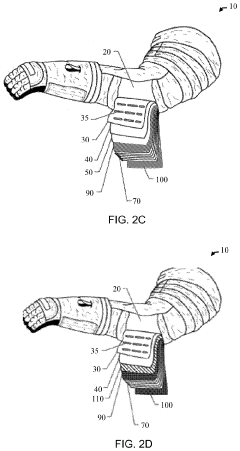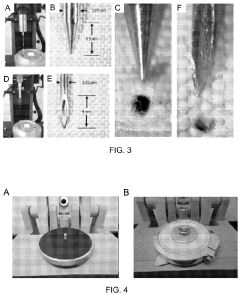How to Advance Kevlar-Rich Fabrics in Aerospace Textiles?
JUL 10, 20259 MIN READ
Generate Your Research Report Instantly with AI Agent
Patsnap Eureka helps you evaluate technical feasibility & market potential.
Kevlar Aerospace Evolution
Kevlar, a high-strength synthetic fiber developed by DuPont in the 1960s, has revolutionized the aerospace industry since its introduction. Initially used in tires and bulletproof vests, Kevlar's exceptional strength-to-weight ratio quickly caught the attention of aerospace engineers. The evolution of Kevlar in aerospace textiles can be traced through several key milestones and technological advancements.
In the 1970s, Kevlar made its debut in aerospace applications, primarily as a lightweight replacement for steel in aircraft components. Its ability to reduce aircraft weight while maintaining structural integrity was a game-changer for fuel efficiency and performance. The 1980s saw the expansion of Kevlar's use in aircraft interiors, particularly in floor panels and overhead storage bins, further contributing to weight reduction and improved safety standards.
The 1990s marked a significant leap in Kevlar's aerospace applications with the development of advanced composites. Kevlar-epoxy composites began to replace traditional materials in critical aircraft structures, such as fuselage panels and wing components. This period also saw the introduction of Kevlar-reinforced aluminum laminates, known as ARALL, which offered superior fatigue resistance and damage tolerance.
The turn of the millennium brought about a new era of innovation in Kevlar-rich fabrics for aerospace. Researchers focused on enhancing Kevlar's already impressive properties through nanotechnology and advanced manufacturing techniques. The development of Kevlar nanocomposites led to even lighter and stronger materials, capable of withstanding extreme temperatures and pressures encountered in aerospace environments.
In recent years, the focus has shifted towards integrating smart technologies with Kevlar-rich fabrics. The incorporation of sensors and conductive materials into Kevlar textiles has paved the way for real-time structural health monitoring of aircraft components. This advancement allows for predictive maintenance and enhanced safety protocols in aerospace operations.
The latest frontier in Kevlar aerospace evolution involves the exploration of bio-inspired designs and structures. Researchers are studying natural materials and structures, such as spider silk and honeycomb patterns, to develop next-generation Kevlar-based materials that mimic nature's most resilient designs. These biomimetic approaches promise to unlock new levels of strength, flexibility, and functionality in aerospace textiles.
As we look to the future, the evolution of Kevlar in aerospace continues to push the boundaries of material science. Ongoing research into hybrid materials, combining Kevlar with other advanced fibers and nanomaterials, holds the potential for creating aerospace textiles with unprecedented properties. The quest for lighter, stronger, and more versatile materials remains at the forefront of aerospace innovation, with Kevlar-rich fabrics playing a pivotal role in shaping the future of flight.
In the 1970s, Kevlar made its debut in aerospace applications, primarily as a lightweight replacement for steel in aircraft components. Its ability to reduce aircraft weight while maintaining structural integrity was a game-changer for fuel efficiency and performance. The 1980s saw the expansion of Kevlar's use in aircraft interiors, particularly in floor panels and overhead storage bins, further contributing to weight reduction and improved safety standards.
The 1990s marked a significant leap in Kevlar's aerospace applications with the development of advanced composites. Kevlar-epoxy composites began to replace traditional materials in critical aircraft structures, such as fuselage panels and wing components. This period also saw the introduction of Kevlar-reinforced aluminum laminates, known as ARALL, which offered superior fatigue resistance and damage tolerance.
The turn of the millennium brought about a new era of innovation in Kevlar-rich fabrics for aerospace. Researchers focused on enhancing Kevlar's already impressive properties through nanotechnology and advanced manufacturing techniques. The development of Kevlar nanocomposites led to even lighter and stronger materials, capable of withstanding extreme temperatures and pressures encountered in aerospace environments.
In recent years, the focus has shifted towards integrating smart technologies with Kevlar-rich fabrics. The incorporation of sensors and conductive materials into Kevlar textiles has paved the way for real-time structural health monitoring of aircraft components. This advancement allows for predictive maintenance and enhanced safety protocols in aerospace operations.
The latest frontier in Kevlar aerospace evolution involves the exploration of bio-inspired designs and structures. Researchers are studying natural materials and structures, such as spider silk and honeycomb patterns, to develop next-generation Kevlar-based materials that mimic nature's most resilient designs. These biomimetic approaches promise to unlock new levels of strength, flexibility, and functionality in aerospace textiles.
As we look to the future, the evolution of Kevlar in aerospace continues to push the boundaries of material science. Ongoing research into hybrid materials, combining Kevlar with other advanced fibers and nanomaterials, holds the potential for creating aerospace textiles with unprecedented properties. The quest for lighter, stronger, and more versatile materials remains at the forefront of aerospace innovation, with Kevlar-rich fabrics playing a pivotal role in shaping the future of flight.
Aerospace Textile Demand
The aerospace industry's demand for advanced textiles has been steadily increasing, driven by the need for lightweight, high-performance materials that can withstand extreme conditions. Kevlar-rich fabrics have emerged as a promising solution, offering exceptional strength-to-weight ratios and thermal stability. The market for aerospace textiles is projected to grow significantly in the coming years, with a particular focus on materials that can enhance fuel efficiency and reduce overall aircraft weight.
The demand for Kevlar-rich fabrics in aerospace applications is primarily fueled by the commercial aviation sector, which is experiencing rapid growth due to increasing air travel and the need for more fuel-efficient aircraft. Military aerospace applications also contribute significantly to this demand, as defense organizations seek advanced materials for aircraft, helicopters, and unmanned aerial vehicles (UAVs).
In the commercial aviation segment, major aircraft manufacturers are increasingly incorporating Kevlar-rich fabrics into various components, including interior panels, flooring, and cargo linings. These materials offer superior fire resistance and impact protection while reducing overall weight, leading to improved fuel efficiency and lower operating costs for airlines.
The space exploration sector represents another growing market for Kevlar-rich aerospace textiles. As both government agencies and private companies invest in space missions, there is a rising demand for materials that can withstand the harsh conditions of space while minimizing payload weight. Kevlar-based fabrics are being explored for use in spacesuits, inflatable habitats, and protective layers for spacecraft.
The UAV market is also driving demand for Kevlar-rich fabrics, as manufacturers seek to develop lighter, more durable drones for both military and civilian applications. These advanced textiles can significantly enhance the performance and endurance of UAVs, making them attractive for a wide range of missions, from surveillance to package delivery.
Environmental concerns and regulatory pressures are further boosting the demand for Kevlar-rich fabrics in aerospace. As governments worldwide implement stricter emissions standards, airlines and aircraft manufacturers are increasingly turning to lightweight materials to improve fuel efficiency and reduce carbon footprints. This trend is expected to accelerate in the coming years, creating new opportunities for Kevlar-rich fabric applications in aerospace.
The aftermarket and maintenance, repair, and overhaul (MRO) sectors also contribute to the growing demand for Kevlar-rich aerospace textiles. As existing aircraft fleets age, there is an increasing need for lightweight, durable materials for retrofitting and repairs, presenting additional market opportunities for advanced fabric solutions.
The demand for Kevlar-rich fabrics in aerospace applications is primarily fueled by the commercial aviation sector, which is experiencing rapid growth due to increasing air travel and the need for more fuel-efficient aircraft. Military aerospace applications also contribute significantly to this demand, as defense organizations seek advanced materials for aircraft, helicopters, and unmanned aerial vehicles (UAVs).
In the commercial aviation segment, major aircraft manufacturers are increasingly incorporating Kevlar-rich fabrics into various components, including interior panels, flooring, and cargo linings. These materials offer superior fire resistance and impact protection while reducing overall weight, leading to improved fuel efficiency and lower operating costs for airlines.
The space exploration sector represents another growing market for Kevlar-rich aerospace textiles. As both government agencies and private companies invest in space missions, there is a rising demand for materials that can withstand the harsh conditions of space while minimizing payload weight. Kevlar-based fabrics are being explored for use in spacesuits, inflatable habitats, and protective layers for spacecraft.
The UAV market is also driving demand for Kevlar-rich fabrics, as manufacturers seek to develop lighter, more durable drones for both military and civilian applications. These advanced textiles can significantly enhance the performance and endurance of UAVs, making them attractive for a wide range of missions, from surveillance to package delivery.
Environmental concerns and regulatory pressures are further boosting the demand for Kevlar-rich fabrics in aerospace. As governments worldwide implement stricter emissions standards, airlines and aircraft manufacturers are increasingly turning to lightweight materials to improve fuel efficiency and reduce carbon footprints. This trend is expected to accelerate in the coming years, creating new opportunities for Kevlar-rich fabric applications in aerospace.
The aftermarket and maintenance, repair, and overhaul (MRO) sectors also contribute to the growing demand for Kevlar-rich aerospace textiles. As existing aircraft fleets age, there is an increasing need for lightweight, durable materials for retrofitting and repairs, presenting additional market opportunities for advanced fabric solutions.
Kevlar Fabric Challenges
Kevlar-rich fabrics face several significant challenges in their application to aerospace textiles, primarily due to the demanding requirements of the aerospace industry. One of the foremost issues is the balance between strength and weight. While Kevlar offers exceptional strength-to-weight ratio, further improvements are necessary to meet the ever-increasing demands of aerospace applications, where every gram matters in fuel efficiency and payload capacity.
The durability of Kevlar fabrics in extreme aerospace environments poses another challenge. These materials must withstand extreme temperature fluctuations, from the intense cold of high altitudes to the heat generated during re-entry. Additionally, they need to resist degradation from UV radiation, ozone, and other atmospheric factors encountered at high altitudes. Enhancing the fabric's resistance to these environmental stressors without compromising its core properties is a complex task.
Manufacturability and scalability present further obstacles. The production of aerospace-grade Kevlar fabrics requires precise control over fiber alignment, weave patterns, and overall uniformity. Achieving consistent quality across large-scale production runs, while maintaining the fabric's advanced properties, remains a significant challenge. This is particularly crucial for aerospace applications, where material inconsistencies can have catastrophic consequences.
The integration of Kevlar fabrics with other materials and systems in aerospace structures is another area of concern. Ensuring proper adhesion and compatibility with composite matrices, as well as developing effective joining techniques for Kevlar-based components, are ongoing challenges. These integration issues are critical for creating seamless, high-performance aerospace structures.
Cost-effectiveness is a persistent challenge in the advancement of Kevlar-rich fabrics for aerospace use. The high cost of raw materials and specialized manufacturing processes can limit the widespread adoption of these advanced textiles. Developing more economical production methods without sacrificing quality is essential for broader implementation in the aerospace industry.
Lastly, the challenge of enhancing multifunctionality in Kevlar fabrics is becoming increasingly important. Beyond mechanical strength, aerospace textiles are expected to provide additional functionalities such as electromagnetic shielding, thermal management, and even self-healing capabilities. Incorporating these diverse properties into Kevlar-rich fabrics without compromising their primary structural functions represents a significant technological hurdle.
The durability of Kevlar fabrics in extreme aerospace environments poses another challenge. These materials must withstand extreme temperature fluctuations, from the intense cold of high altitudes to the heat generated during re-entry. Additionally, they need to resist degradation from UV radiation, ozone, and other atmospheric factors encountered at high altitudes. Enhancing the fabric's resistance to these environmental stressors without compromising its core properties is a complex task.
Manufacturability and scalability present further obstacles. The production of aerospace-grade Kevlar fabrics requires precise control over fiber alignment, weave patterns, and overall uniformity. Achieving consistent quality across large-scale production runs, while maintaining the fabric's advanced properties, remains a significant challenge. This is particularly crucial for aerospace applications, where material inconsistencies can have catastrophic consequences.
The integration of Kevlar fabrics with other materials and systems in aerospace structures is another area of concern. Ensuring proper adhesion and compatibility with composite matrices, as well as developing effective joining techniques for Kevlar-based components, are ongoing challenges. These integration issues are critical for creating seamless, high-performance aerospace structures.
Cost-effectiveness is a persistent challenge in the advancement of Kevlar-rich fabrics for aerospace use. The high cost of raw materials and specialized manufacturing processes can limit the widespread adoption of these advanced textiles. Developing more economical production methods without sacrificing quality is essential for broader implementation in the aerospace industry.
Lastly, the challenge of enhancing multifunctionality in Kevlar fabrics is becoming increasingly important. Beyond mechanical strength, aerospace textiles are expected to provide additional functionalities such as electromagnetic shielding, thermal management, and even self-healing capabilities. Incorporating these diverse properties into Kevlar-rich fabrics without compromising their primary structural functions represents a significant technological hurdle.
Current Kevlar Solutions
01 Kevlar-reinforced composite fabrics
Composite fabrics incorporating Kevlar fibers to enhance strength and durability. These fabrics often combine Kevlar with other materials to create high-performance textiles suitable for various applications, including protective gear and industrial uses.- Kevlar-reinforced composite fabrics: Composite fabrics incorporating Kevlar fibers to enhance strength and durability. These fabrics often combine Kevlar with other materials to create high-performance textiles suitable for various applications, including protective gear and industrial uses.
- Kevlar-based protective clothing: Specialized clothing and gear made primarily from Kevlar-rich fabrics, designed to provide superior protection against various threats such as ballistic impacts, cuts, and abrasions. These garments are commonly used in military, law enforcement, and high-risk industrial environments.
- Kevlar fabric manufacturing techniques: Advanced manufacturing processes and techniques specifically developed for producing Kevlar-rich fabrics. These methods focus on optimizing the fabric's properties, such as strength-to-weight ratio, flexibility, and heat resistance, while ensuring consistent quality and performance.
- Kevlar fabric treatments and coatings: Various treatments and coatings applied to Kevlar-rich fabrics to enhance their properties or add specific functionalities. These may include water-repellent finishes, fire-retardant treatments, or coatings that improve abrasion resistance or UV protection.
- Kevlar fabric applications in specialized equipment: Integration of Kevlar-rich fabrics into specialized equipment and gear for specific industries or applications. This includes the use of Kevlar in aerospace components, sporting goods, automotive parts, and other high-performance products that require exceptional strength and lightweight properties.
02 Kevlar-based protective clothing
Specialized clothing and gear made primarily from Kevlar-rich fabrics, designed to provide superior protection against various threats such as ballistic impacts, cuts, and abrasions. These garments are commonly used in military, law enforcement, and high-risk occupations.Expand Specific Solutions03 Kevlar fabric manufacturing techniques
Advanced manufacturing processes and techniques specifically developed for producing Kevlar-rich fabrics. These methods focus on optimizing the fabric's properties, such as strength-to-weight ratio, flexibility, and heat resistance, while ensuring consistent quality in production.Expand Specific Solutions04 Kevlar fabric treatments and coatings
Various treatments and coatings applied to Kevlar-rich fabrics to enhance their properties or add specific functionalities. These may include water-repellent finishes, fire-retardant treatments, or coatings that improve abrasion resistance or UV protection.Expand Specific Solutions05 Kevlar fabric applications in specialized equipment
Utilization of Kevlar-rich fabrics in the design and construction of specialized equipment and gear. This includes applications in aerospace, automotive, sports equipment, and other fields where high-strength, lightweight materials are crucial for performance and safety.Expand Specific Solutions
Aerospace Textile Leaders
The advancement of Kevlar-rich fabrics in aerospace textiles is in a mature yet evolving stage, with a growing market driven by increasing demand for lightweight, high-strength materials in the aerospace industry. The global market for advanced aerospace materials is projected to reach significant growth in the coming years. Technologically, companies like Airbus Operations GmbH, Northrop Grumman Systems Corp., and Lockheed Martin Corp. are at the forefront, continuously innovating to enhance the performance of Kevlar-rich fabrics. Research institutions such as Massachusetts Institute of Technology and Fraunhofer-Gesellschaft are also contributing to technological advancements, focusing on improving the material's properties and exploring new applications in aerospace.
Airbus Operations GmbH
Technical Solution: Airbus has pioneered the use of Kevlar-rich fabrics in aerospace applications through their "Smart Textiles" initiative. Their approach focuses on integrating electronic components and sensors directly into Kevlar-based fabrics, creating multifunctional materials for aircraft interiors and structural components[2]. Airbus has developed a proprietary weaving technique that allows for the seamless incorporation of conductive fibers alongside Kevlar, enabling real-time monitoring of structural integrity and environmental conditions[4]. Additionally, they have made significant advancements in the area of fire-resistant Kevlar composites, utilizing nano-additives to enhance flame retardancy without compromising the material's mechanical properties[6]. Airbus is also exploring the use of bio-based precursors for Kevlar production, aiming to reduce the environmental impact of aerospace textile manufacturing[8].
Strengths: Advanced integration of smart technologies, improved fire resistance, and focus on sustainability. Weaknesses: Potential increase in complexity of maintenance and repair procedures for smart textiles.
Northrop Grumman Systems Corp.
Technical Solution: Northrop Grumman has made significant strides in advancing Kevlar-rich fabrics for aerospace applications, particularly in the realm of ballistic protection and structural reinforcement. Their research focuses on developing multi-layered Kevlar composites that offer enhanced protection against high-velocity impacts and extreme temperatures[7]. The company has introduced a novel process for creating three-dimensional Kevlar weaves that provide superior energy absorption capabilities compared to traditional 2D fabrics[9]. Northrop Grumman has also developed a proprietary surface treatment for Kevlar fibers that improves their adhesion to matrix materials, resulting in stronger and more durable composites for aerospace structures[11]. Furthermore, they are exploring the integration of phase-change materials within Kevlar fabrics to create adaptive thermal management systems for spacecraft and high-altitude aircraft[13].
Strengths: Advanced ballistic protection, innovative 3D weaving techniques, and thermal management capabilities. Weaknesses: Potentially higher production costs and limited scalability for some specialized applications.
Kevlar Fabric Innovations
Ballistic helmets and method of manufacture thereof
PatentActiveUS20170027268A1
Innovation
- The use of thermoplastic matrix composite materials, specifically 0/90 cross-plied uni-directional para-aramid or UHMWPE fibers bonded with a thermoplastic matrix resin, and a hydroforming process to create a helmet preform with no cuts, seams, or wrinkles, allowing for improved fiber orientation and energy absorption.
High tenacity textiles containing shear thickening fluid and uses thereof
PatentActiveUS20210140099A1
Innovation
- Intercalation of shear thickening fluids (STFs) into high tenacity fibers within textiles, which increases resistance to puncture, cutting, abrasion, and dust penetration while maintaining flexibility and reducing outgassing by using low volatility carrier fluids and specific particle concentrations.
Aerospace Safety Standards
Aerospace safety standards play a crucial role in the advancement of Kevlar-rich fabrics for aerospace textiles. These standards are designed to ensure the highest level of safety and performance in aerospace applications, where the consequences of failure can be catastrophic. The Federal Aviation Administration (FAA) and the European Union Aviation Safety Agency (EASA) are the primary regulatory bodies that establish and enforce these standards.
For Kevlar-rich fabrics to be approved for use in aerospace applications, they must meet stringent requirements outlined in various standards. These include FAR 25.853 and CS-25, which specify flammability and smoke emission requirements for materials used in aircraft interiors. Additionally, standards such as RTCA DO-160 address environmental conditions and test procedures for airborne equipment, including textiles.
The development of Kevlar-rich fabrics for aerospace applications must also consider standards related to mechanical properties. These include tensile strength, tear resistance, and abrasion resistance, as outlined in ASTM D5034 and ASTM D1424. The fabrics must maintain their structural integrity under extreme conditions, including high temperatures and pressures encountered during flight.
Electromagnetic interference (EMI) shielding is another critical aspect addressed by aerospace safety standards. Kevlar-rich fabrics used in aerospace applications must comply with standards such as MIL-STD-461, which outlines requirements for the control of electromagnetic interference characteristics of subsystems and equipment.
To advance Kevlar-rich fabrics in aerospace textiles, manufacturers must continuously innovate to meet and exceed these safety standards. This involves developing new fiber blends, weave patterns, and surface treatments that enhance the fabric's performance across multiple criteria simultaneously. For instance, incorporating conductive materials into the Kevlar fabric structure can improve EMI shielding without compromising its mechanical properties.
Furthermore, aerospace safety standards are continually evolving to address new challenges and technologies. Manufacturers of Kevlar-rich fabrics must stay abreast of these changes and participate in industry working groups to contribute to the development of future standards. This proactive approach ensures that innovations in Kevlar-rich fabrics align with the latest safety requirements and can be swiftly adopted in aerospace applications.
For Kevlar-rich fabrics to be approved for use in aerospace applications, they must meet stringent requirements outlined in various standards. These include FAR 25.853 and CS-25, which specify flammability and smoke emission requirements for materials used in aircraft interiors. Additionally, standards such as RTCA DO-160 address environmental conditions and test procedures for airborne equipment, including textiles.
The development of Kevlar-rich fabrics for aerospace applications must also consider standards related to mechanical properties. These include tensile strength, tear resistance, and abrasion resistance, as outlined in ASTM D5034 and ASTM D1424. The fabrics must maintain their structural integrity under extreme conditions, including high temperatures and pressures encountered during flight.
Electromagnetic interference (EMI) shielding is another critical aspect addressed by aerospace safety standards. Kevlar-rich fabrics used in aerospace applications must comply with standards such as MIL-STD-461, which outlines requirements for the control of electromagnetic interference characteristics of subsystems and equipment.
To advance Kevlar-rich fabrics in aerospace textiles, manufacturers must continuously innovate to meet and exceed these safety standards. This involves developing new fiber blends, weave patterns, and surface treatments that enhance the fabric's performance across multiple criteria simultaneously. For instance, incorporating conductive materials into the Kevlar fabric structure can improve EMI shielding without compromising its mechanical properties.
Furthermore, aerospace safety standards are continually evolving to address new challenges and technologies. Manufacturers of Kevlar-rich fabrics must stay abreast of these changes and participate in industry working groups to contribute to the development of future standards. This proactive approach ensures that innovations in Kevlar-rich fabrics align with the latest safety requirements and can be swiftly adopted in aerospace applications.
Environmental Impact
The environmental impact of advancing Kevlar-rich fabrics in aerospace textiles is a critical consideration in the development and application of these materials. Kevlar, a high-strength synthetic fiber, offers exceptional properties for aerospace applications, but its production and use have significant environmental implications.
The manufacturing process of Kevlar involves energy-intensive procedures and the use of harmful chemicals. The primary raw material, para-phenylenediamine, is derived from petroleum, contributing to the depletion of non-renewable resources. The polymerization and spinning processes require substantial energy inputs, leading to increased carbon emissions. Additionally, the use of sulfuric acid in the production process poses potential environmental risks if not properly managed.
However, the durability and lightweight nature of Kevlar-rich fabrics can contribute to improved fuel efficiency in aerospace applications. By reducing the overall weight of aircraft and spacecraft, these materials help decrease fuel consumption and, consequently, lower greenhouse gas emissions during operation. This long-term benefit may partially offset the environmental costs associated with production.
The disposal of Kevlar-rich fabrics at the end of their lifecycle presents another environmental challenge. These materials are not biodegradable and can persist in the environment for extended periods. Recycling options for Kevlar are limited, although research is ongoing to develop more effective recycling methods. The aerospace industry must consider implementing closed-loop systems and exploring innovative recycling technologies to mitigate the environmental impact of waste Kevlar materials.
Advancements in Kevlar-rich fabrics for aerospace textiles should focus on improving the sustainability of the production process. This may include developing more eco-friendly synthesis methods, utilizing renewable energy sources in manufacturing, and exploring bio-based alternatives that maintain the high-performance characteristics of Kevlar. Additionally, research into enhancing the recyclability and end-of-life management of these materials is crucial for reducing their overall environmental footprint.
The aerospace industry's adoption of Kevlar-rich fabrics must be balanced with a comprehensive life cycle assessment to fully understand and address the environmental implications. This approach will ensure that the benefits of these advanced materials in terms of performance and fuel efficiency are not outweighed by negative environmental impacts throughout their lifecycle.
The manufacturing process of Kevlar involves energy-intensive procedures and the use of harmful chemicals. The primary raw material, para-phenylenediamine, is derived from petroleum, contributing to the depletion of non-renewable resources. The polymerization and spinning processes require substantial energy inputs, leading to increased carbon emissions. Additionally, the use of sulfuric acid in the production process poses potential environmental risks if not properly managed.
However, the durability and lightweight nature of Kevlar-rich fabrics can contribute to improved fuel efficiency in aerospace applications. By reducing the overall weight of aircraft and spacecraft, these materials help decrease fuel consumption and, consequently, lower greenhouse gas emissions during operation. This long-term benefit may partially offset the environmental costs associated with production.
The disposal of Kevlar-rich fabrics at the end of their lifecycle presents another environmental challenge. These materials are not biodegradable and can persist in the environment for extended periods. Recycling options for Kevlar are limited, although research is ongoing to develop more effective recycling methods. The aerospace industry must consider implementing closed-loop systems and exploring innovative recycling technologies to mitigate the environmental impact of waste Kevlar materials.
Advancements in Kevlar-rich fabrics for aerospace textiles should focus on improving the sustainability of the production process. This may include developing more eco-friendly synthesis methods, utilizing renewable energy sources in manufacturing, and exploring bio-based alternatives that maintain the high-performance characteristics of Kevlar. Additionally, research into enhancing the recyclability and end-of-life management of these materials is crucial for reducing their overall environmental footprint.
The aerospace industry's adoption of Kevlar-rich fabrics must be balanced with a comprehensive life cycle assessment to fully understand and address the environmental implications. This approach will ensure that the benefits of these advanced materials in terms of performance and fuel efficiency are not outweighed by negative environmental impacts throughout their lifecycle.
Unlock deeper insights with Patsnap Eureka Quick Research — get a full tech report to explore trends and direct your research. Try now!
Generate Your Research Report Instantly with AI Agent
Supercharge your innovation with Patsnap Eureka AI Agent Platform!
